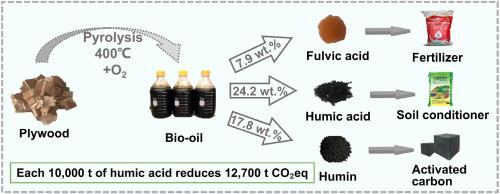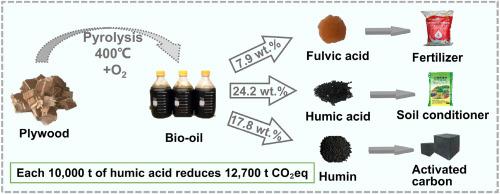Oxidative pyrolysis of biomass waste: Efficient production of humic substances with enhanced agricultural potential and environmental benefits
IF 10
1区 环境科学与生态学
Q1 ENGINEERING, ENVIRONMENTAL
引用次数: 0
Abstract
This study reports an innovative oxidative pyrolysis-based technology for the high-value conversion of biomass waste, achieving efficient co-production of humic acid (24.2 wt%), fulvic acid (7.9 wt%), and humin (15.0 wt%) under optimized reaction conditions (400 °C, <5 min). This breakthrough addresses long-standing challenges in humic acid production, particularly in terms of efficiency and energy consumption. Multi-scale characterization techniques, including FTIR and TG, revealed unique structural features of the products: compared to standard humic acid, the humic acid and humin derived from oxidative pyrolysis exhibit a higher proportion of lightweight components (e.g., carboxylic acids, polysaccharides, and phenols), lower aromaticity, and reduced molecular weight. These characteristics, characterized by low polymerization and high bioactivity, significantly enhance their potential for agricultural applications. A life cycle assessment (LCA) further quantified the environmental benefits of this technology, demonstrating a reduction of 12,700 tons of CO2-equivalent emissions per 10,000 tons of humic acid produced, alongside a waste resource utilization rate of approximately 75 %. The work establishes a rapid waste-to-product conversion route, elucidates transformation mechanisms, and provides a sustainable biomass utilization model, advancing green agriculture.


生物质废弃物的氧化热解:高效生产腐殖质物质,提高农业潜力和环境效益
本研究报告了一种创新的基于氧化热解的生物质废弃物高价值转化技术,在优化的反应条件(400°C, 5分钟)下,实现了腐植酸(24.2% wt%)、黄腐酸(7.9 wt%)和腐植酸(15.0% wt%)的高效协同生产。这一突破解决了腐植酸生产中长期存在的挑战,特别是在效率和能源消耗方面。红外光谱(FTIR)和热重(TG)等多尺度表征技术揭示了产物的独特结构特征:与标准腐植酸相比,氧化热解生成的腐植酸和腐植酸具有更高比例的轻质成分(如羧酸、多糖和酚类)、更低的芳构性和更小的分子量。这些特性具有低聚合和高生物活性的特点,大大提高了它们在农业上的应用潜力。生命周期评估(LCA)进一步量化了该技术的环境效益,表明每生产10,000吨腐植酸可减少12,700吨二氧化碳当量排放量,同时废物资源利用率约为75%。建立废弃物快速转化路径,阐明转化机制,提供生物质可持续利用模式,推进绿色农业。
本文章由计算机程序翻译,如有差异,请以英文原文为准。
求助全文
约1分钟内获得全文
求助全文
来源期刊

Journal of Cleaner Production
环境科学-工程:环境
CiteScore
20.40
自引率
9.00%
发文量
4720
审稿时长
111 days
期刊介绍:
The Journal of Cleaner Production is an international, transdisciplinary journal that addresses and discusses theoretical and practical Cleaner Production, Environmental, and Sustainability issues. It aims to help societies become more sustainable by focusing on the concept of 'Cleaner Production', which aims at preventing waste production and increasing efficiencies in energy, water, resources, and human capital use. The journal serves as a platform for corporations, governments, education institutions, regions, and societies to engage in discussions and research related to Cleaner Production, environmental, and sustainability practices.
 求助内容:
求助内容: 应助结果提醒方式:
应助结果提醒方式:


